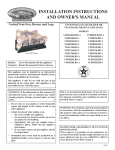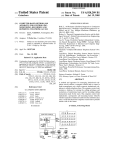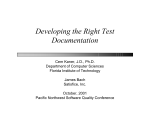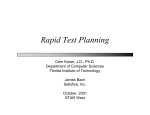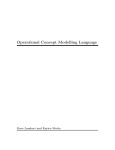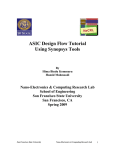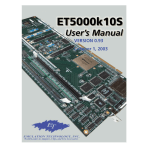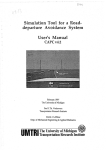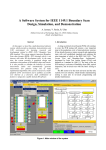Download A system for fault diagnosis and simulation of VHDL descriptions
Transcript
A System for Fault Diagnosis and Simulation of VHDL descriptions Vijay Pitchumani Pankaj Mayor Nimish Ftadia Department of Electrical and Computer Engineering Syracuse University, Syracuse NY 13244. Abstract This paper describes a compiler and algorithms for simulation and fault diagnosis of computer hardware modeled in VHSIC Hardware Description Language(VHDL). Given a VHDL description, the compiler creates an internal representation. For simulation, a discrete-event based compiled code simulation algorithm is used. For fault diagnosis, a hierarchical approach using the stuck-at fault model a t the first level and the arbitrary failure model at the second level, is used. The diagnosis algorithm reasons from first principles using constraint suspension. 1. Introduction VHDL has already become a standard language for specification and simulation of computer hardware [1,2,3,4]. It is a rich language that permits design description at several levels of abstraction - behavioral level, RTL level, and gate level. It also permits structural hierarchy to be described. For simulation and other CAD applications, it is necessary to compile VHDL descriptions into an internal representation. The internal representation may be meant to support interpretive or compiled code approach. For runtime efficiency we have chosen the compiled code approach [5]. Specifically the internal representation we have chosen is executable C code. We have chosen a subset of VHDL for our purposes, and have developed a VHDL to C Code Generator (VCCG). Given a VHDL description, VCCG produces equivalent C code and C data structures that capture connectivity information. This combination of C code and C data structures constitutes our design database. The design database contains enough pointers to facilitate forward and backward tracing of the design. VCCG is different from existPermission to copy without fee all or part of this material is granted provided that the copies are not made or distributed for direct commercial advantage, the ACM copyright notice and the title of the publication and its date appear, and notice is given that copying is by permission of the Association for Computing Machinery. To copy otherwise, or to republish, requires a fee and/or specific permission. ing compilers; the internal representation it produces is useful not only for simulation but for other CAD application tools such as fault diagnosis and test generation as well. The currently available VHDL simulators use a discrete-event based simulation algorithm. We have developed a VHDL simulator (VSIM), which uses a discrete-event based compiled code simulation algorithm. The concept of fault diagnosis of computer hardware is not new. There are many AI-based and nonAI-based approaches. Within AI, there are two approaches for fault diagnosis. The first approach uses “rules”. Each rule specifies a symptom/fault pairing [6,7,8,9]. Such rules are created for each design. Given a set of symptoms, these rules give a set of possible faults for a particular design. As the complexity of VLSI designs increases, the rule-based approach becomes impractical [10,11]. The second approach uses the concept of reasoning from first principles. It uses the structure and behavior of the given design for fault diagnosis [10,11]. The reasoning from first principles is time consuming. Some modifications of these algorithms have been suggested to improve efficiency [121. Some AI-based algorithms for fault diagnosis consider only stuck-at fault model [7], while some consider hierarchy of fault models [ 10,11]. Although stuck-at faults accouiit for most of the faults in the circuits, they are not the only type of faults which can cause misbehavior [ll].Hence, diagnosis algorithms using only stuck-at fault model fail to diagnose the design if it has faults other than stuck-at faults [ll]. Suppose we have a VHDL description for a given hardware design. The hardware consists of physical devices which are subject to failure. This failure can lead to a misbehavior of the hardware. As the description is in VHDL, design engineers might want to locate the portion of the VHDL description whose implementation in the hardware is causing the observed misbehavior. This requires fault diagnosis of 28th ACM/IEEE Design Automation Conference” Paper 10.2 144 1991 ACM 0-89791-395-7/91/0006/0144 $1.50 VlIDL descriptions. So far no tools have been available to do fault diagnosis on VHDL descriptions. We have developed a VHDL Fault DiagnosisTool (VFDT). Given a VHDL design description and a set of test cases, VFDT intelligently tries to isolate the fault to one or more VHDL constructs., VFDT assumes a single point of failure and uses ’both the stuck-at fault model and the arbitrary fault model. The diagnosis is performed hierarchically using constraint suspension. The fault diagnosis approach we have developed for VFDT is a modified version of Davis’s [ll] approach. VSIM and VFDT are capable of handling both combinational and sequential circuits. However, VFDT requires that latches be controllable and observable; input vectors and observed outputs are stated in terms of latches as well as primary inputs (PI’S) and primary outputs (PO’s). 2. VCCG L Sum Cin I Figure 1: A 1-bit adder - The VHDL Compiler We have chosen a subset of VHDL for fault diagnosis and simulation. The subset is large enough to represent any digital system. The main features of this subset are: (a) concurrent statements, (b) sequential statements, except wait statement, (c) component instantiation and configuration specification statement, and (d) libraries. The details of this subset are given in [13]. C subroutines. Even if there are multiple instances of a concurrent statement (by virtue of multiple component instances) only one copy of the corresponding C code will exist. However, as mentioned before there will be a separate data area for each instance. Thus different instances of a concurrent statement will share C subroutines to process a set of data values associated with them. VCCG represents each concurrent VHDL statement and any of its instances as a C structure in the design database. Memory is allocated to represent this structure. This way, each instance of a concurrent VHDL statement has memory to store the data values associated with it. For example, consider the I-bit adder shown in Fig. 1 and its corresponding description in VHDL in Fig. 2. In this example, the architecture body of the adder uses two instances X1 and X2 of the entity xor. The VHDL description of the xor gate is given in Fig. 3. For such cases, the entity informations related to X1 and X2 are stored in separate memory areas. Similarly, the architecture informations related to X1 and X2 are also stored in separate memory locations. Similarly, all other concurrent statements and their instances are represented as C structures. This methodology facilitates implementation of multiple instances of any concurrent VHDL statement. We define a 9-process (“generalized process”) to be a process statement or any concurrent VHDL statement which can be mapped to an equivalent VNDL process statement. Given any VHDL description, we will represent it as a network of g-processes. For the 1-bit adder described in Fig. 2, we have a g-process corresponding to each concurrent statement as seen in Fig. 4. X1 and X2, the xor gate instantiations each have 3 concurrent signal assignment statements as seen from Fig. 3, contributing g-processes gpl-gp3 and gp4-gp6 respectively. The two concurrent signal assignment statements in the architecture body of the adder contribute g-processes gp7 and gp8. The process statement P contributes g-process gp9. This network of g-processes is used by the simulation and the fault diagnosis tools. The computations associated with a VHDL concurrent statement (process statement, concurrent signal assignment statement, etc) are transformed by VCCG into a sequence of C statements and stored as A g-process is an atomic construct for the siniulation and the fault diagnosis tools. Each g-process is represented as C subroutines as described previously. The VHDL description is simulated by executing the C subroutines associated with its g-processes. For fault diagnosis using the arbitrary fault model, the diagnostic resolution is limited to a g-process. Paper 10.2 145 -the entity description for a 1 bit adder entity adder is port(A, B, Cin : in bit; Sum, Cout: out bit); end adder ; -an architecture description for a 1 bit adder architecture mixed of adder is component xor-gate port ( X, Y: in bit; Z : out bit) ; for X1, X2: xor-gate use entity gates.xor(xorarch) ; port map(In1 + X , In2 3 Y, Out =+ Z); signal L, M, N : bit ; begin X1: xor-gate port map (A, B, L); X2: xor-gate port map (L, Cin, Sum); M e L and C ; N+AandB; P: process(M,N ) begin Carry e M or N ; end process ; end mixed; Figure 2: VHDL description of a 1-bit adder 3. VSIM - The VHDL Simulator We have developed a simulator [13] for simulating circuits described in VHDL. VSIM is capable of simulating the chosen subset of VHDL. It handles high level as well as hierarchical designs in VHDL. The elaboration of a design hierarchy produces a model which is a network of g-processes. Given the VHDL description (Fig. 2) of the adder in Fig. 1, the components in the top level design entity are instantiated and a network of g-processes, as seen in Fig. 4, is created. This is done by VLINK the VHDL Linker. Simulation involves execution of these interacting g-processes. VSIM’s kernel coordinates the activity of the g-processes during a simulation. It propagates and updates signal values. It is also responsible for detecting events that occur, and for causing appropriate g-processes to execute in response to these events. VSIM is an event driven simulator. It maintains a driver for each signal of each g-process. Each driver of a signal is a source of values for that signal. Transactions (signal changes) that are created by a g-process for a signal are put in the driver queue of Paper 10.2 146 -the entity description for the XOR gate entity xor is port(In1, In2 : in bit; Out: out bit); end xor; -an architecture for the above XOR gate architecture xor-arch of xor is signal S1, S2 : bit; begin S1 G (not I n l ) and In2; S2 e In1 and (not In2); Out S l or S2; end xor-arch; Figure 3: VHDL description of an xor gate that signal of that g-process. Obviously, if a signal is shared by several g-processes, it will have multiple drivers, one per g-process. This implementation facilitates the use of resolved signals - signals that have more than one source. VHDL has a two-stage model of time referred to as the simulation cycle. It is based on a generalized model of the stimulus and response behavior of digital hardware. The g-processes respond to activity on their inputs with a response on their outputs. During the first stage of the simulation cycle new values scheduled to take effect at that time are assigned to signals and are propagated to their sinks. All the signals scheduled to obtain new values at the current simulation time are updated. Changes in the values of these signals could cause some g-processes to become sensitized. During the second stage of the simulation cycle, the sensitized g-processes are executed till they are suspended. Execution of a g-process may create transactions on signals which are put on the corresponding driver queues. At the completion of the simulation cycle, the simulation clock is set to the time-stamp of the earliest transaction that is scheduled to occur. Then the cycle is repeated. 4. Fault Diagnosis by Constraint Suspension Constraint suspension is a way of diagnosing faults by reasoning from first principles using knowledge of the structure and behavior of the circuit. The diagnosis is performed hierarchically by gradually relaxing the assumptions about the failure modes of the circuit. Based on an engineer’s notion of-things that can go wrong, categories of failure are defined. Amongst erroneous PO can possibly be responsible for the incorrect behavior. This defines a set of potential candidates. The candidates are in the context of the domain of the fault category being considered; that is, they may be signals or g-processes. This is called discrepancy detection. ‘ri= Figure 4: Network of g-processes corresponding to the 1-bit adder these failure categories, some are encountered more frequently than others. These categories of failure can be ordered based on the above metric with the more commonly occurring category of failure preceding the less commonly occurring one. For example we could have the following ordering of failure categories: 0 0 stuck-at faults (for level 1 diagnosis) change in behavior of g-processes (for level 2 diagnosis) Once a set of potential candidates has been generated we apply constraint suspension to them to determine if they are consistent - that is if they could explain the observed behavior. In general, a signal or a g-process imposes a relation (or constraints) between its inputs and outputs. When we do constraint suspension for a candidate, we disable the constraints associated with it. This amounts to disconnecting the candidate’s outputs from the candidate so that these outputs, which are now pseudo-PI’S, are free to assume any value necessary to cause the observed values on the PO’s. Procedurally, we assign the given primary input values to thePI’s and the observed primary output values t o the PO’s. Then we determine if there is an assignment of values to the pseudo-PI’S that will cause the circuit to reach a consistent state. If there is such an assignment, the candidate continues to remain a candidate; otherwise we conclude that the candidate cannot account for the symptoms. Clearly, this approach differs from traditional fault diagnosis methods in that it reasons from first principles and is general enough to permit arbitrary failure of a g-process. The algorithm presented in this paper is essentially the same as that of [ll];however it differs from [ll]in the following ways: etc Candidates, faults which can explain the misbehavior of the circuit, are first generated for the stuckat fault category. We assume initially that the components behave correctly. Only if this assumption fails to give us a candidate which explains the observed misbehavior, would we move on to the next category of faults and perform diagnosis under this new model. We use transitive fanin of a signal or a g-process to denote the set of all signals and g-processes from which it is reachable. Similarly, transitive fanovt of a signal or a g-process denotes the set of all signals that are reachable from it. The two central issues to this method of fault diagnosis are discrepancy detection and constraint suspension. For a given set of primary inputs, if any observed primary output is different from the corresponding good machine (predicted) PO, only the signals and g-processes in the transitive fanin of this it introduces VHDL specific concepts and techniques into the algorithm it uses simulation oriented, but efficient, methods for inferencing thereby making use of the compiled code generated for simulation for inferencing as well 5. VFDT - The VHDL Fault Diagnosis Tool We have developed a fault diagnosis tool [14] implementing a modified constraint suspension algorithm, which will intelligently try to diagnose the fault to one or more signals or g-processes. In an actual hardware implementation there need not be a one-bone correspondence between g-processes and hardware units. When the fault is diagnosed to a g-process gp, the physical meaning is that the fault lies somewhere within the set of hardware units which together contain gp. VFDT accepts the following as input: Paper 10.2 147 0 a design description in VHDL test data - applied test vectors and the observed responses of the circuit It will return a set of either signals or g-processes or both which could consistently explain the erroneous behavior of the circuit. In general the test data available to VFDT may contain many test vectors. Ideally VFDT should be able to resolve the fault location to a signal or a g-process. In general diagnostic resolution will increase with the number of test cases. VFDT itself will not generate tests t o narrow the set of candidates. VFDT deals with single point of failure fault models and performs fault diagnosis hierarchically. First it tries to locate the fault assuming the stuck-at fault model. Failing this, it relaxes the assumption that the g-processes are behaving correctly and allows them to fail in any arbitrary way - that is, their truth table may change in any way. Hence, the second level fault model is called the arbitrary-failure model. This takes into account the fact that the module may fail in any arbitrary way. This is a very comprehensive model and would cover most of the faults in the circuit. There are three broad steps in the algorithm. We will discuss each of them individually. 5.1 Test case selection From the fault diagnosis point of view, a test case (i.e. an input test vector and the corresponding observed output) is useful, if any of the observed and expected PO’s are different. The test case selection module takes each given test case and simulates it using VSIM. If the observed output is not identical to the simulated (good machine) output, VFDT accepts the test case; otherwise VFDT rejects the test case. If a test case is accepted, the good machine simulation values at each signal are saved for future use. An interesting point to note about the test cases is that it is not necessary to specify all PI’S and all PO’s. It is possible to leave some of them unspecified. This is particularly useful when dealing with sequential circuits. 5.2 Topological candidate generation The next phase in fault diagnosis is topological candidate generaiion. Initially the set S of candidates Paper 10.2 148 includes all the signals or all the g-processes in the circuit. After a test case is accepted by the test case selection module, the PO’s which have a discrepancy between the observed and the predicted values are identified. For each of these erroneous PO’s, the set SNEW of signals or g-processes that are in its transitive fanin is computed. The intersection of S and SNEW is placed in S. The modified set S contains the current candidates. Since we are assuming a single point of failure, the candidates thus generated should be in the transitive fanin of all of the erroneous PO’s. The sets S and SNEW are not computed explicitly, nor is the intersection performed explicitly. To save processing time, we use a counter COUNT for each stuck-at fault (for level 1 diagnosis) or g-process (for level 2 diagnosis) to indicate whether that fault is a candidate. If X is a candidate and X is in the transitive fanin of the next erroneous PO, then we increment the COUNT of X by 1. This constitutes a transitive f a n i n check. We record in a global variable CUR-COUNT the total number of transitive fanin checks performed so far. If COUNT of a candidate X equals CUR-COUNT, then X continues to be a candidate. While dealing with the stuck-at fault model we can take advantage of the fact that if a fault F is a s-a-i (stuck-at-i) fault and the good machine value at the fault site is i , the misbehavior could not have been caused by F. Hence F can be removed from the set S. This would further reduce the number of candidates which could explain the error. 5.3 Candidate consistency check After doing topological candidate generation with a new test case, we compute the percentage decrease in the cardinality of set S due to the past k test cases. If the computed value is less than an empirically determined threshold, we stop the topological candidate generation phase and move on to checking for consistency of each candidate. This is the candidate consistency check phase. Candidate consistency check is performed differently for the stuck-at fault model and for the arbitrary-failure model. For the stuck-at fault model we know that the signals could misbehave in either of two ways - they could either be s-a-0 or s-a-1. Candidate consistency check for this fault model is performed by fault simulation. Procedurally, we take a test case and retrieve the good machine simulation values at all signals for it. Then we pick a candidate, inject the corresponding fault in the circuit (that is, create a transaction representing this fault) and perform event-driven simulation. If the simulated outputs are identical to the observed outputs for this test case, the candidate continues to remain a candidate; otherwise it is dropped from the set of candidates. We then repeat the above steps for the remaining candidates and the remaining test cases. For the arbitrary-failure model, we need to use a different strategy as we have no information as to how a g-process might have failed. For a chosen candidate, we do constraint suspension i.e. we disconnect the candidate from its outputs to create pseudo-PI’S and try to determine an assignment to these pseudoPI’s which is consistent with the values observed at the PO’s. This involves inferencing for which we use one of the following two strategies: e Full forward Simulation (FFS) e Backward inference with forward simulation (BIFS) We use a heuristic figure of merit (FOM) to choose between these two strategies. FOM is computed based on the number of unspecified outputs of the candidate g-process (that is, number of unspecified pseudo-PI’S) and the distance of the candidate g-process from the PO’s. Obviously all pseudo-PI’S will be initially unspecified. However, as explained later, FOM is also used to switch to FFS after having done some BIFS. FFS is used when the candidate is either close to the PO’s or the number of pseudo-PI’S is small (that is, FOM is less than an empirically determined threshold). For a test case, we retrieve the good machine simulation values on all signals, assign a value to the pseudo-PI’S (that is, create transactions with the assigned values) and simulate the network for this assignment in an event-driven mode. Only those signals that are in the transitive fanout of the candidate are affected by this simulation; other signals retain their good machine values. If the simulated values at the PO’s are identical to the observed values, we have found a consistent assignment at the pseudo-PI’s; otherwise we assign different values to the pseudo-PI’S and repeat the above process. BIFS is the other inferencing strategy used. It is selected when FFS is not chosen. As in FFS, we disconnect the candidate from its outputs. Then we do the following: 1. Assign the given input values to the PI’s and the observed output values to the PO’s of the circuit. For all other signals, we retrieve the good machine simulation values for this test case. Mark all signals in the transitive fanout of the candidate, except the PO’s, as unspecified. SNJ-procs are defined as g-processes that have one or more output signals specified but are not justified. We can now define an SNJ-frontier which is initialized as follows. If a g-process gp has an output that is an erroneous PO, then gp is put in the SNJ-frontier. Clearly such a gp is an SNJ-proc. As the algorithm proceeds, SNJfrontier will always be the frontier of SNJ-procs that have been reached by backward inferencing from the erroneous PO’s. If the SNJfrontier is empty goto 8; else heuristically pick a gp from the SNJ-frontier. This heuristic depends on ratio of the number of specified inputs and outputs to the total number of inputs and outputs of gp, as well as the complexity of gp. Find an assignment at the inputs of gp which satisfies the values on the outputs of gp. This involves assigning different values, one by one, to the inputs of gp and simulating it; repeat this till the simulated and existing values at the outputs of the gp are consistent. If all assignments are exhausted unsuccessfully, goto 8. 5 . Implicate, both forward and backward, the val- ues assigned to signals in the previous step. Here we use another heuristic to decide whether we should implicate forward through a g-process. This heuristic is based on the ratio of specified inputs of the g-process to the total number of inputs of the g-process. We implicate through those g-processes for which this ratio is greater than an empirically determined threshold. Backward implication propagates values from sink signals to source signals. Any g-process feeding such a source signal will be added to the SNJfrontier if it is not already there. 6. If implication reveals an inconsistency, backtrack on the signal last assigned a value, make an alternate consistent assignment, modify SNJfrontier and perform implication. 7. If FOM for the candidate g-process is now less than an empirically determined threshold, switch from BIFS to FFS to find an assignment for the remaining unspecified pseudo-PI’S of the candidate. Paper 10.2 149 8. If a consistent assignment has been found for the pseudo-PI’S, the candidate continues to remain a candidate; otherwise it is removed from the set of candidates. There is a third strategy for doing inferencing which is similar to BIFS except that forward simulation is not used in step 4 of the above algorithm. Instead, inferencing is done inside the g-process. This strategy is not implemented currently because we are using the compiled code generated for simulation purposes also for fault diagnosis. If we use an interpretive approach for simulation, the parse trees of VHDL statements that are interpreted by the simulator can be used by the fault diagnosis tool as well for inferencing inside a g-process. 6. Results and Conclusions We have developed algorithms for, and implemented a suite of tools to aid in designing digital circuits using VHDL. Currently simulation (logic and timing) and fault diagnosis are supported. The database permits other tools to be added in the future. The approach that we have followed for fault diagnosis is not specific to any hardware; it can diagnose faults in any hardware described in VHDL. The diagnosis tool is very powerful; it is not limited to stuck-at faults. [3] D. R. Coelho, The V H D L Handbook, Kluwer Academic Publishers, Norwell, MA , 1989. [4] J . R. Armstrong, Chip-Level Modeling with V H D L , Prentice Hall, Englewood Cliffs, NJ, 1989. 151 M. A.Breuer, Design Automation of Digital Syst e m s , Prentice Hall, Englewood Cliffs, NJ, 1972. [6] R. T. Hartley, “CRIB: Computer Fault Finding Through Knowledge Engineering”, I E E E Computer, pages 76-83, March 1984. [7] L. Apfelbaum, “An Expert System for In-circuit Fault Diagnosis”, Proceedings of International Test Conference, pp. 868-874, 1985. [8] 0. Grillmeyer and A. J . Wilkinson, “The Design and Construction of a Rule Base and an Inference Engine for Test System Diagnosis”, Proceedings of International Test Conference, pp. 857-867, 1985. [9] Y. Baron, “Self Diagnostics on System Level by Design” , Proceedings of International Test Conference, pp. 921-927, 1986. [lo] M. R. Genesereth, “The use of Design Descriptions in Automated Diagnosis”, Artificial Inielligence pp. 411-436, December 1984. It is obvious that fault simulation capability is built into the fault diagnosis tool. It would be a relatively simple matter to build an explicit fault simulator o u t of it. [ l l ] R. Davis, “Diagnostic Reasoning Based on Structure and Behavior”, Artificial Intelligence, pp. 347-410, December 1984. Acknowledrrements [12] K.H. Thearling and R. K. Iyer, “Diagnostic Reasoning in Digital Systems”, Proceedings of the 18th International Symposium o n Fault Tolerant Computing, pp. 286-291, 1988. The authors would like to thank Neeta Ganguly, Elton Huang, Jainendra Kumar and Rizwan Muhammad for their coding contributions. This work has been supported in part by Coherent Research Inc. and NASA. References [l] IEEE Standard VHDL Language Reference Manual, IEEE Inc., New York, NY, March 1988. [2] R. Lipsett, C. Schaefer and C. Ussery, V H D L : Hardware Description and Design, Kluwer Academic Publishers, Norwell, MA, 1989. Paper 10.2 150 [13] VSIM User Manual, Syracuse University, 1990. [14] VFDT User Manual, Syracuse University, 1990.









